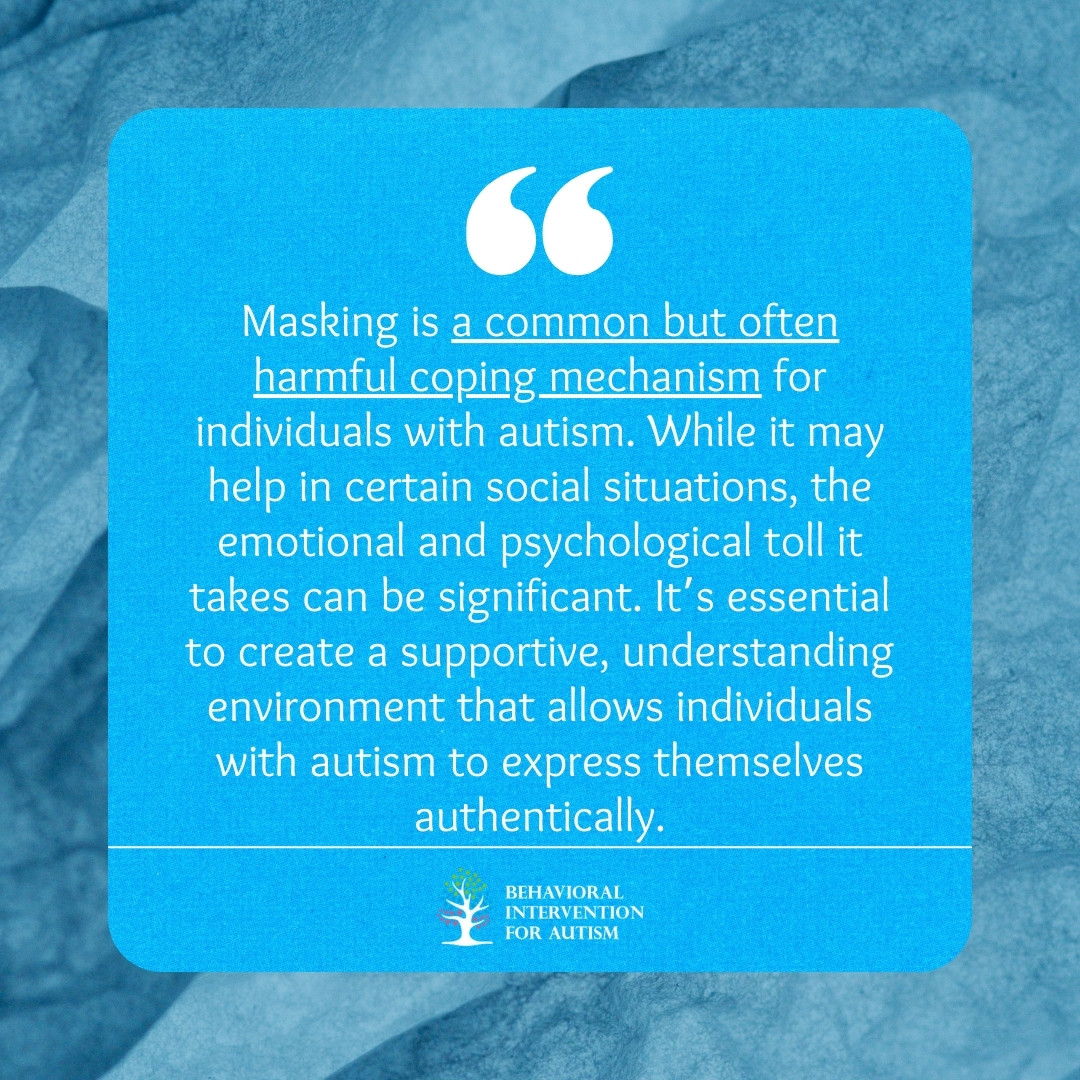
Table of Contents
Masking in autism refers to the act of suppressing natural behaviors, emotions, and responses in social situations to fit in or meet societal expectations. Individuals with autism spectrum disorder (ASD) often feel pressured to hide their authentic selves, which can lead to a range of emotional and psychological challenges. This phenomenon is particularly common among those with high-functioning autism, and its effects can significantly impact an individual’s well-being.
In this article, we will delve into the concept of masking, its causes, the challenges it presents, and strategies to help individuals with autism cope with the pressure to mask. By understanding masking and its effects on mental health, we can support those on the autism spectrum in living more fulfilling, authentic lives.
What is Masking in Autism?
Masking refers to the conscious or unconscious effort to hide behaviors that are often associated with autism. This can include stimming (repetitive movements or sounds), difficulty with eye contact, social awkwardness, or intense focus on specific topics. Masking is a survival strategy that individuals with autism use to navigate social settings and interact with others in a way that is considered “normal” by societal standards.
Individuals who mask may suppress or mimic social behaviors that feel unnatural to them in order to avoid standing out. This can be particularly challenging in childhood and adolescence when social expectations and peer pressure are more pronounced. As a result, many individuals with autism experience significant emotional strain from constantly pretending to be something they are not.
Masking may become more prominent with age, especially if a person feels they need to integrate into their environment to avoid judgment or exclusion. While masking may help in certain situations, it can lead to burnout, exhaustion, and increased anxiety when the individual can no longer maintain the facade. Over time, this constant effort to mask can take a heavy toll on mental health and emotional stability.
The Causes of Masking in Autism
Masking is often driven by external pressures, including societal expectations, family dynamics, and educational environments. Some of the primary causes of masking in individuals with autism include:
1. Social Pressure to Conform
From an early age, individuals with autism may notice that they behave differently from their peers. This difference often becomes more apparent as children reach school age, where social interactions become more complex. The desire to fit in with others and avoid being ostracized can lead individuals with autism to hide their authentic behaviors.
The pressure to conform can come from both explicit and implicit sources, such as teachers, peers, and family members. The emphasis on “appropriate” behavior often leaves little room for individuals to express themselves freely. Consequently, masking becomes a strategy for survival in social situations.
2. Fear of Judgment or Rejection
Many individuals with autism are highly sensitive to the possibility of being judged or rejected by others. This fear can lead them to mask behaviors they feel might cause others to view them as strange or different. For example, someone may suppress their stimming or avoid eye contact because they fear it will lead to ridicule or exclusion.
This fear of judgment can become even more pronounced during adolescence, a time when social relationships and peer approval take on greater importance. As a result, masking can become a default coping mechanism, leading individuals to hide who they truly are to avoid the pain of rejection.
3. Lack of Understanding from Others
Another significant cause of masking is the lack of understanding about autism from those around the individual. When society is not well-educated about the different ways autism manifests, individuals may feel compelled to mask their behaviors to meet the expectations of a neurotypical world. For example, a person might avoid expressing emotions in a way that feels natural to them because they know it will be misinterpreted or misunderstood.
This lack of understanding extends to environments such as schools, workplaces, and even families. Without proper support, individuals with autism may struggle to advocate for themselves, leaving them feeling isolated and unheard.
The Psychological and Emotional Effects of Masking
While masking may help individuals with autism navigate social situations in the short term, it can have significant long-term psychological and emotional effects. Constantly suppressing one’s true self can lead to a variety of mental health challenges, including:
1. Anxiety and Stress
The constant effort to mask can be mentally exhausting. Many individuals with autism experience heightened anxiety and stress as they try to conform to social expectations while hiding their true feelings and behaviors. The fear of being “found out” or judged can create a sense of perpetual worry, leaving individuals with little emotional energy to engage with others authentically.
Anxiety related to masking can manifest in both social and general contexts. Individuals may feel anxious in new situations, anticipating that they will not be able to mask successfully. This can lead to social withdrawal, avoidance of certain environments, or even panic attacks.
2. Depression and Low Self-Esteem
Over time, the emotional strain caused by masking can contribute to depression and low self-esteem. When individuals feel that they must constantly pretend to be someone they are not, it can lead to a sense of identity confusion. They may begin to question their worth or feel like they are not accepted for who they truly are.
Additionally, the isolation that often comes with masking—especially when others do not understand or accept the individual’s autism—can deepen feelings of loneliness. Without genuine connections, individuals with autism may feel disconnected from others and experience depressive symptoms.
3. Burnout and Exhaustion
Masking can be physically and emotionally draining, and over time, individuals with autism may experience burnout. This is a state of complete mental and physical exhaustion from the prolonged effort of masking. Burnout can lead to emotional meltdowns, social withdrawal, and an overwhelming sense of fatigue.
When burnout occurs, the individual may no longer have the energy to continue hiding their true self, leading to periods of intense emotional release or shutdowns. This is often misunderstood by those around the person, further contributing to feelings of frustration and isolation.
Strategies for Coping with Masking
While masking is often an instinctive response to societal pressures, there are ways for individuals with autism to cope with the challenges it presents. The goal is to create an environment where individuals feel safe enough to express themselves authentically without fear of judgment.
1. Self-Awareness and Acceptance
The first step in overcoming the negative effects of masking is developing self-awareness and acceptance. Individuals with autism should be encouraged to explore and understand their unique traits, strengths, and challenges. When they accept themselves for who they are, they are more likely to feel empowered to stop masking and embrace their true selves.
Support from family members, educators, and therapists is essential in fostering self-awareness and acceptance. It’s important to remind individuals with autism that it’s okay to be different and that their authentic self is valuable.
2. Safe and Supportive Environments
Creating safe and supportive environments is crucial in reducing the need for masking. Individuals with autism should be able to express themselves freely without fear of judgment or exclusion. Schools, workplaces, and social spaces should be inclusive and understanding of neurodiversity.
In these environments, individuals can practice social skills without the pressure to conform. This might include allowing for alternative forms of communication, such as using visual supports or technology, and providing flexibility in social interactions.
3. Therapeutic Support
Therapies such as cognitive-behavioral therapy (CBT) and social skills training can be beneficial for individuals who struggle with masking. CBT can help individuals recognize and challenge negative thought patterns related to social interactions, while social skills training can provide practical tools for navigating social situations without the need to mask.
Therapists can also work with individuals to explore and express their true emotions, helping them feel more comfortable being authentic in different settings. In some cases, therapy may also focus on managing the stress and anxiety that can arise from masking.

Fostering self-awareness, creating supportive spaces, and seeking therapeutic support can help individuals with autism reduce the need for masking and embrace their true selves. Through education, acceptance, and compassion, we can build a world that celebrates neurodiversity, where everyone has the freedom to be themselves.
Understanding Masking in Autism and How We Can Help
Masking is a common behavior in individuals with autism, where they hide or suppress their natural reactions to blend in with others. This can be mentally exhausting and may contribute to increased stress or burnout. Recognizing the signs of masking is essential for providing the right support. Behavioral Intervention For Autism offers tailored ABA programs in Florida to address the unique challenges that come with masking. Our compassionate team uses evidence-based strategies to create a personalized approach that supports self-expression and emotional well-being. If you’re ready to make a positive change, contact us today to learn more about our services!
Sources:
https://www.autism.org.uk/advice-and-guidance/topics/behaviour/masking
- 9 Common Obsessions of Children With Autism You Should Know - February 25, 2025
- What is Neurodiversity? A Guide to Embracing Differences - February 25, 2025
- Understanding Hyperfocus in Autism: What It Means and Why It Happens - February 25, 2025



